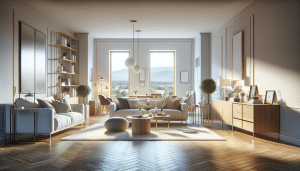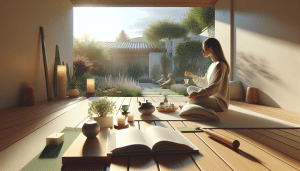Surprising Ways You Can Refresh Your Home Decor
Jessica White October 18, 2025
Explore innovative ideas and simple strategies for updating home decor, creating inviting rooms, and reflecting current interior design trends. Discover achievable tips that blend personal style with practical solutions, boosting comfort and beauty in living spaces you use every day.
Creative Approaches to Updating Your Living Room
The living room often sets the tone for a home’s overall vibe, making it a priority for those interested in home improvements. One fresh approach is rearranging the furniture layout to encourage conversation and flow. By moving sofas to face each other or adding a cozy reading nook, your main gathering area can feel more open and intentional. Layering rugs, incorporating soft throws, or displaying artwork in clever groupings also makes a difference. Small changes, such as new lamps or decorative cushions, can highlight interior design trends without requiring a complete overhaul (Source: https://www.architecturaldigest.com/story/how-to-decorate).
Lighting choices hold a powerful impact on space perception. Swapping heavy curtains for light, breezy fabrics allows more sunlight in, creating a brighter mood. Consider incorporating statement light fixtures or adding LED strip lighting behind bookshelves and under furniture for visual interest. Many homeowners find that updating lampshades or pendant lights helps achieve a trendy, energetic look and can even influence how spacious rooms appear. Reflecting light off mirrors multiplies that effect, offering an inviting atmosphere for daily living and entertainment.
Bold accent walls remain popular among interior designers. Painting one wall in a vibrant shade—think deep green or terracotta—creates instant character. Removable wallpaper with geometric or botanical prints is another update that’s easy to switch out as style interests change. For those who prefer subtle upgrades, infusing the space with texture via woven baskets, velvet cushions, or chunky knit blankets brings warmth and depth. It’s not just about aesthetics; thoughtful living room updates can also support relaxation and social connection, two essentials in contemporary home life.
Incorporating Sustainable Materials into Home Aesthetics
Sustainability is reshaping interior design choices, offering environmentally responsible paths for those revamping their décor. Using recycled wood for shelves or coffee tables not only supports eco-friendly living but brings distinctive character to a room. Bamboo, for example, has surged in popularity for blinds, flooring, and decorative accents due to its renewability and light finish. Repurposed metal and glass items, commonly sourced from local artisans or thrift stores, add vintage charm while reinforcing sustainable living values (Source: https://www.epa.gov/greenliving/reducing-materials-waste).
Natural fibers—like cotton, jute, and linen—are being used for area rugs, curtains, and upholstery throughout homes focused on modern wellness. These fabrics breathe better, provide a relaxed ambiance, and are safe for households with sensitive allergies. Eco-conscious households may also consider energy-efficient upgrades such as insulated window treatments or solar-powered lighting elements, which serve both functional and aesthetic purposes. These integrated solutions provide long-term value, reducing energy expenses and environmental impacts while making spaces more visually dynamic.
Items with a transparent sourcing trail, such as Fair Trade-certified décor, add deeper meaning to any room design. Choosing products with a story or contributing to social initiatives introduces conversations beyond style. Upcycled planters, baskets, and crafts also fit seamlessly into modern aesthetics, tying together the appeal of sustainable living with trending décor practices. Each addition, however small, signals a thoughtful approach to creating a more personal and responsible home environment.
Personalization Through Art, Collectibles, and Memories
Art and personal collections breathe life into spaces, reflecting the unique passions of those living there. One simple method is crafting a gallery wall showcasing favorite photographs, prints, and canvas pieces. Mixing frame styles and sizes achieves an artful, curated effect that sparks interest and conversation. Incorporating artifacts or souvenirs from meaningful trips, or displaying inherited treasures, gives rooms a direct connection to memories. These home decor choices allow every visitor to glimpse the personality behind the space (Source: https://www.metmuseum.org/toah/hd/intd/hd_intd.htm).
Handmade ceramics, vintage records, and small sculptures can all become focal points in living rooms or bedrooms. It’s easier than ever to find unique local art at markets or through online galleries. Personalized accents—like a handwoven tapestry or commissioned painting—enhance both emotional connection and overall style. These pieces often spark creativity and serve as daily mood boosters. Moving items occasionally or seasonally refreshing the display prevents monotony and keeps the home feeling engaging year-round.
Displaying collectibles—whether cameras, books, or travel mementos—invites curiosity and encourages storytelling. Organizing these treasures on open shelving or shadow boxes creates visual interest. For those seeking a sense of balance, grouping by color, theme, or material can unify diverse collections for a harmonious look. Ultimately, integrating personal artifacts alongside trend-focused updates results in design choices that feel authentic—making a house feel truly lived in and loved.
Maximizing Small Spaces With Smart Interior Design
Modern lifestyles often mean dealing with compact living spaces, especially in urban settings. Multifunctional furniture—like sleeper sofas, folding tables, or ottomans with built-in storage—offers flexibility for changing needs. Open shelving creates vertical storage while showing off plants or favorite finds. Designing with dual-purpose items maximizes square footage and ensures no corner goes unused. Mirrors and glass-topped tables maintain an airy atmosphere, which is crucial for making small homes feel more expansive (Source: https://www.houzz.com/magazine/8-ways-to-make-a-small-living-room-look-bigger-stsetivw-vs~18173671).
Neutral color palettes are often chosen for their space-enhancing effects. Soft whites, light grays, and pastels allow natural light to reflect further, while subtle pops of color in pillows or artwork add interest without overwhelming the eye. Clear organizational strategies—such as basket storage, modular cabinets, and wall-mounted racks—help keep clutter contained. Floating shelves above desks or dressers introduce additional room for storage or decoration, supporting both efficiency and creativity in daily life.
Outdoor-inspired elements—like potted plants or framed nature prints—establish a calming connection to “the outside” regardless of square footage. Bringing greenery indoors improves air quality and contributes to a peaceful aesthetic. Vertical gardening, hanging planters, and compact herb gardens fit even in the smallest apartments. This biophilic design approach fosters relaxation, boosts well-being, and turns small interiors into refreshing escapes from busy routines.
Blending Style and Function in Kitchen and Dining Spaces
Kitchens and dining areas benefit from styles that promote togetherness and easy living. Open shelving highlights beautiful dishware, adds personality, and makes essentials easily accessible. Flexible furniture, such as extendable tables or rolling islands, adapts to different occasions—supporting everyday meals and celebrations alike. High-traffic areas profit from durable, stain-resistant surfaces and finishes, combining practicality with form. The right balance, according to many designers, lies in layering textures, patterns, and color for a lived-in, up-to-date look (Source: https://www.nkba.org/resource/2023-kitchen-bath-design-trends-report/).
Effective storage solutions are integral to stylish kitchens. Pull-out shelves, deep drawers, and vertical storage keep clutter at bay and maximize efficiency. Glass canisters filled with colorful ingredients double as both visual accents and handy organizers. Using baskets or minimalist containers for countertop items maintains a streamlined look, while well-placed lighting under cabinets highlights both function and style. The kitchen thus becomes not just a workspace but a space of creativity and family gathering.
Dining spaces have evolved to meet modern needs for flexibility, comfort, and digital connectivity. Incorporating multi-use nooks that serve as workstations, study spaces, or entertainment spots has become commonplace. Swapping mismatched chairs, using statement pendant lights, or displaying fresh-cut flowers can transform a conventional dining area into an inviting, multi-functional setting. Blending personal taste with practical upgrades ensures these spaces feel uniquely suited to current lifestyles and special moments alike.
Trendy Accents and Seasonal Decor Swaps
Refreshing home decor goes beyond big projects—it’s often about small, on-trend details. Updating throw pillows, blankets, and table accessories to reflect the latest colors and patterns keeps rooms feeling current. In spring and summer, lighter fabrics and botanical prints energize interiors, while autumn and winter call for chunky knits, cozy colors, and wooden accents. Candle arrangements, scented diffusers, and new artwork are effortless ways to keep your home evolving throughout the year (Source: https://www.housebeautiful.com/room-decorating/tips/g20259536/spring-decor-tips/).
Seasonal swaps offer a chance to experiment with personal style without committing to long-term changes. Rotating decorative trays, pottery, and seasonal wreaths provides visual stimulation and celebrates transitions throughout the year. Embracing this rhythm of change offers both excitement and an ongoing opportunity to refine your space in line with your favorite interior design trends. It’s a practice adopted by designers and hobbyists alike to rekindle inspiration at home.
Even minimal changes—a new table runner, an area rug, or updated plant holders—can spark a sense of renewal after months of the same setup. Decorating for seasons and special occasions helps anchor memories and traditions, creating touchpoints that friends and family look forward to. Over time, such intentional tweaks support a living space that grows and changes with those who inhabit it.
References
1. Architectural Digest. (n.d.). How to Decorate: Expert Tips for Styling Your Home. Retrieved from https://www.architecturaldigest.com/story/how-to-decorate
2. United States Environmental Protection Agency. (n.d.). Reducing Materials & Waste for a Sustainable Future. Retrieved from https://www.epa.gov/greenliving/reducing-materials-waste
3. The Metropolitan Museum of Art. (n.d.). The Interior: Modern Life and Decorative Art. Retrieved from https://www.metmuseum.org/toah/hd/intd/hd_intd.htm
4. Houzz. (n.d.). 8 Ways to Make a Small Living Room Look Bigger. Retrieved from https://www.houzz.com/magazine/8-ways-to-make-a-small-living-room-look-bigger-stsetivw-vs~18173671
5. National Kitchen & Bath Association. (n.d.). 2023 Kitchen & Bath Design Trends Report. Retrieved from https://www.nkba.org/resource/2023-kitchen-bath-design-trends-report/
6. House Beautiful. (n.d.). Spring Decor: 50 Simple Ideas for Every Room. Retrieved from https://www.housebeautiful.com/room-decorating/tips/g20259536/spring-decor-tips/








